Global Burden and Challenges of Melioidosis
A special issue of Tropical Medicine and Infectious Disease (ISSN 2414-6366). This special issue belongs to the section "One Health".
Deadline for manuscript submissions: closed (31 January 2018) | Viewed by 153356
Special Issue Editors
Interests: infection; microbiology; epidemiology; statistics; tropical infectious diseases; melioidosis and antimicrobial resistance
Special Issue Information
Dear Colleagues,
A recent spatial modelling study estimated that there are about 165,000 human melioidosis cases per year worldwide, of which 89,000 (54%) end in death. Globally, mortality due to melioidosis (89,000 per year) is comparable to measles, and higher than that for leptospirosis and dengue infections.
Nonetheless, melioidosis is so neglected that it is missing from all the lists of neglected tropical diseases. The spatial modelling study suggested that melioidosis is severely under-reported in the 45 countries in which it is known to be endemic, and likely to be present in a further 34 countries, which have never reported the disease. It is crucial, now, to carefully compare the numbers predicted by the model and the numbers confirmed by researchers, clinicians and diagnostic laboratories, and to identify gaps in the current surveillance of melioidosis in each country. This will be essential for both national and international policy makers to help determine the allocation of the limited resources available for public health to save lives from melioidosis.
National surveillance data for melioidosis are non-existent in most countries. It is likely that there are many different gaps in surveillance systems in different melioidosis-endemic tropical countries. Melioidosis can be difficult to diagnose due to its diverse clinical manifestations, the limited availability of microbiological laboratories serving the rural poor who are most likely to contract the disease, a lack of familiarity of doctors and laboratory staff with the clinical and bacteriological features, and the inadequacy of conventional bacterial identification methods. Furthermore, Burkholderia pseudomallei is intrinsically resistant to a wide range of commonly used antimicrobials, and treatment with ineffective antimicrobials results in high mortality. Access, availability and rational usage of effective antimicrobials for melioidosis in resource-limited countries are rarely discussed. Awareness and commitment from policy makers and all stakeholders for melioidosis are crucial, and availability of relevant information is limited.
This Special Issue is dedicated to exploring and discussing the burden and challenges of melioidosis in each country, region or continent. We encourage the submission of contributions, specific to a country, region or continent, in the following areas: (1) observed evidence of melioidosis, (2) current standards and availability of measures to diagnose, report, treat and prevent melioidosis, (3) current public awareness, awareness among healthcare providers, and actions in relation to melioidosis from Ministries of Health, (4) major findings, changes or achievements against melioidosis during the last five years (2012–2016/7), and (5) future challenges relating to melioidosis. Observed evidence should include a review of the evidence of infections in humans, animals and the presence of the organism in the environment, including both indigenous and exported cases. Measures to diagnose, report, treat and prevent melioidosis should discuss recommended measures, and the availability and diversity of those measures across the whole country, region or continent. Actions in relation to melioidosis from Ministries of Health should discuss the existence (or non-existence) and quality of notifiable disease systems, laboratory-based surveillance systems, formal announcements, support, and any campaigns against melioidosis in the country, region or continent.
We look forward to your useful contributions on this interesting and important topic.
Prof. Dr. David AB Dance
Dr. Direk Limmathurotsakul
Guest Editors
Manuscript Submission Information
Manuscripts should be submitted online at www.mdpi.com by registering and logging in to this website. Once you are registered, click here to go to the submission form. Manuscripts can be submitted until the deadline. All submissions that pass pre-check are peer-reviewed. Accepted papers will be published continuously in the journal (as soon as accepted) and will be listed together on the special issue website. Research articles, review articles as well as short communications are invited. For planned papers, a title and short abstract (about 100 words) can be sent to the Editorial Office for announcement on this website.
Submitted manuscripts should not have been published previously, nor be under consideration for publication elsewhere (except conference proceedings papers). All manuscripts are thoroughly refereed through a single-blind peer-review process. A guide for authors and other relevant information for submission of manuscripts is available on the Instructions for Authors page. Tropical Medicine and Infectious Disease is an international peer-reviewed open access monthly journal published by MDPI.
Please visit the Instructions for Authors page before submitting a manuscript. The Article Processing Charge (APC) for publication in this open access journal is 2700 CHF (Swiss Francs). Submitted papers should be well formatted and use good English. Authors may use MDPI's English editing service prior to publication or during author revisions.
Keywords
-
Melioidosis
-
Burkholderia pseudomallei
-
Epidemiology
-
Human cases
-
Animal cases
-
Environment
-
Diagnosis
-
Microbiological laboratory
-
Reporting system
-
Notifiable disease
-
National surveillance report
-
Treatment
-
Prevention
-
Public awareness
-
Healthcare workers’ awareness
-
Policy makers’ awareness
-
Policy
-
Resources








